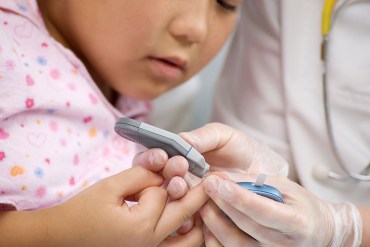Childhood diabetes rates are on the rise, and a report released Monday pointed to the impact that the cost of their care could have on families — even those who have employer-sponsored health insurance.
The study, conducted by the Health Care Cost Institute (HCCI), found that children as old as 18 with diabetes who were insured through an employer-sponsored plan racked up $2,173 per capita in out-of-pocket health care costs in 2014. That spending level was nearly five times higher than that of kids without the illness.
The HCCI researchers analyzed data from claims submitted from 2012 to 2014 through group, individual and Medicare Advantage insurance policies to analyze health care spending and utilization trends among people younger than 65 who had diabetes and employer-sponsored coverage plans.
In terms of use of medical services, children with diabetes visited the emergency room 2.5 times more often than children without it. Acute inpatient services were used nearly five times more often. In all, a year’s worth of care cost $17,380 — the second only to adults aged 55 through 64 with diabetes.
Although more prescriptions and frequent doctor’s visits help explain the difference in the health care costs generated by children with and without this illness, researchers were still surprised by the magnitude of the disparity.
Families are “spending more out-of-pocket across the board on all types of services,” said Amanda Frost, a senior researcher at HCCI. “And it’s just higher use. So when you end up using all of these health care services, you end up with a very personal impact on your wallet, especially if you’re a parent with a child with diabetes.”

As of 2012, 208,000 children and adolescents younger than 20 years old lived with diabetes, most of whom have Type I diabetes, which is when the body does not produce insulin, according to the latest data from the Centers for Disease Control and Prevention (CDC). And the rates are surging. In the past 30 years, the total number of cases for all age groups has quadrupled. Childhood Type II diabetes, often associated with obesity, is rising, especially among racial minorities.
Prescription drugs accounted for the largest share of the out-of-pocket costs for children with diabetes in each year of the study period, peaking in 2014 at $751 per child, driven by spending on brand-name prescriptions. For all other age groups studied, these costs decreased by at least 3 percent.
The price of insulin, the drug used to treat Type I diabetes has skyrocketed. A study published in JAMA in March found the drug cost an average of $12.92 per milliliter in 2013. With children with Type I diabetes needing daily anywhere from .5 to 1.5 units of insulin per kilogram of their weight, Dr. Fran Cogen, director of the Childhood and Adolescent Diabetes Program at Children’s National Health System said, the price and the burden can rack up quickly.
Cogen also said families who struggle with the financial burden of diabetes treatment wrestle with more issues than the bottom line. Mental health and access to other resources is also a concern in assessing the well-being of the child, adding another layer of cost and complexity in treating children.
“Not only do you have to deal with the diabetes, you have to deal with underlying socio-economic conditions and psychological conditions and their need,” Cogen said.
Among the researchers’ other conclusions:
- Per capita spending for insured people with diabetes increased between 2012 and 2014 by $1,310 to $16,021 in 2014, nearly four times higher than spending for people without the illness, which was $4,396.
- Spending was the highest for adults between the ages of 55 through 64.
- Increases in out-of-pocket spending for people with diabetes corresponded with the overall rise in costs. However, there were drops in spending on prescription drugs — especially among the oldest age group. This decline is attributed to less spending on brand-name prescription medicines.
- The total cost of health care among those with diabetes tended to decrease with age. Expenditures among those without diabetes trended in the opposite direction.
Note: This story was updated to reflect the correct measures for insulin for children with Type I diabetes.






